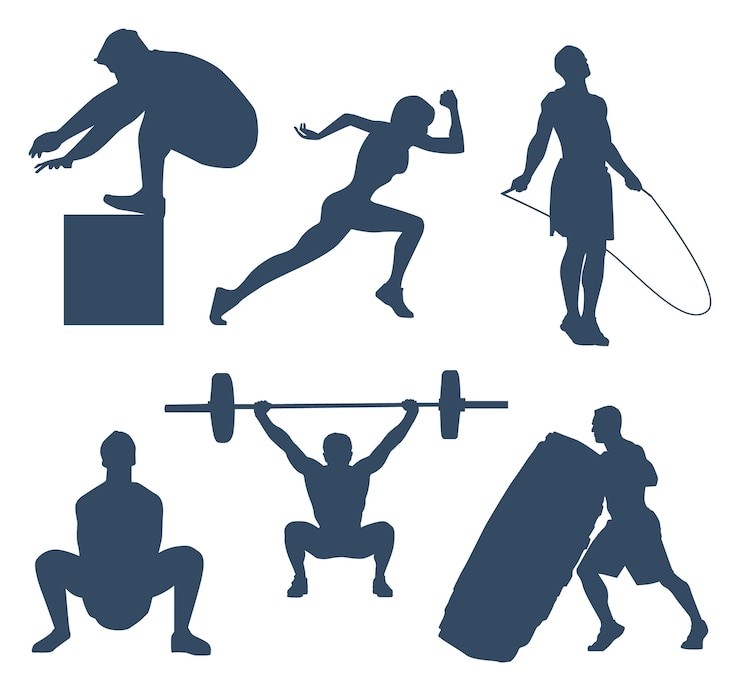High-Intensity Interval Training
Exercise routines that combine short bursts of intense exercise with rest intervals are referred to as “HIIT” workouts. A HIIT exercise will typically last 10 to 30 minutes. Despite the fact that the activity was brief, the health advantages were comparable to doing twice as much moderate-intensity exercise. Depending on the exercise, it could involve sprinting, biking, jumping rope, or other bodyweight activities. Strength training and cardio are combined in HIIT to provide a powerful and effective workout.
But where do you even begin? To help you satisfy your high-intensity interval training craving, we’ve rounded up 3 of the most efficient HIIT workouts below.
- AMRAP
The phrase “as many rounds as possible” simply refers to doing all of your exercises or rounds within the specified time. You may set a timer for 20 minutes and perform as many rounds of a loop of six exercises as you are able to during that time. AMRAP training is a good technique to maintain a close eye on your fitness because it’s simple to assess your performance to past efforts. E.g., Exercises for weightlifting or strength training, such as kettlebell swings, deadlifts, or hip thrusters with a barbell or dumbbell for the glutes, should be combined with push-ups, air squats, pull-ups, lunges, sit-ups, and mountain climbers.
- The Battle Ropes Blitz
Your pulse rate will increase only by rapidly and aggressively moving the fighting ropes. So, start performing slams or waves using a pair of battle ropes, and continue for 30 seconds. Take approximately a minute to relax. Repeat ten times.
- TABATA
You can jump-start your system into action and quickly burn fat in just 4 minutes. The only exercises in a traditional TABATA HIIT workout are the first one and the second one. The first activity is performed continuously for 20 seconds at full intensity, followed by a 10-second break. Continue till the 4 minutes have passed. E.g. Push-ups. High knees/running in place, Skate lunges, Mountain climbers.
Benefits of HIIT
- It’s efficient and effective: For professionals who are busy, HIIT activities are ideal because of their brief duration. Everyone has a few minutes they can allocate for a quick HIIT session, even if they don’t have sufficient time in their schedule to go to the gym.
- It should come as no surprise that studies show a positive correlation between heart health and HIIT, with improved blood circulation and lower cholesterol both reported in those regularly engaging in this training since working out at a high intensity has a significant impact on our heart and VO2 levels.
- You burn more fat: Your repair cycle accelerates to match your body’s full exertion during HIIT, allowing you to burn more fat more quickly.
Cons of HIIT:
Since HIIT places a great deal of stress on the body, its effects are frequently noticeable right away. This kind of demanding exercise, though, can only be sustained for so long. It can overstress your body and perhaps result in injuries if done repeatedly every day for a long time. Here are some Cons regarding the same:
- HIIT users incur a much higher incidence of injury according to research.
- Not everyone should do HIIT. To push oneself to the maximum, you need to have strong physical endurance and motivation. Your muscles and joints may suffer from sprains and strains if you are not accustomed to this form of workout.
- Dizziness: Your blood pressure may drop quickly if you alternate between standing and sitting quickly, which will make you feel lightheaded. If this occurs, you should pause until you are ready to resume.
LOWER INTENSITY INTERVAL TRAINING (LIIT)
Lower Intensity Interval Training, or LIIT, refers to exercising less intensely for longer periods of time but yet giving yourself plenty of time to recover. And because you are doing less strenuous exercises like walking, running, or swimming, you will be able to maintain your stamina far more readily than you would with a higher-impact fitness regimen. Contrary to high-intensity interval training (HIIT), which alternates brief bursts of intense activity with low-intensity rest periods, it is the antithesis of HIIT.
LIIT workout examples include:
Hiking on a path that alternates between level areas and severe inclines wearing a weight belt sometimes when exercising walking while alternating with pushups, pullups, and lunges as part of a circuit.
Now that we are clear about the meaning of LIIT, lets explore some benefits of LIIT:
- improves mood
- improved cardiac health
- bolsters muscle power
- controls blood pressure
- increases fitness endurance
Drawbacks Of LIIT:
- It necessitates lengthier cardio workouts, usually lasting 45 to 60 minutes, this may seem as a drawback because some people cannot remove that time out of their schedule.
- It could lead to a loss in muscle mass if overdone.
- It is less effective at building bone density.
Which is better for me?
Now that we have gained general overall information about LIIT and HIIT, lets discuss which one is the best foe who and when should we opt for both of these workout routines:
If you’re typically in good shape and active, your exercise regimen should include both high- and low-intensity exercises. High intensity exercise is a fantastic technique to burn calories and increase your cardiorespiratory fitness, while low intensity exercise can be a fantastic recovery day training approach.
The intensity rate of the workouts is the primary distinction between the two styles of training. However, some people could prefer HIIT to LIIT or vice versa. This is only due to how easily the regimens can be incorporated into your daily routine and how simple they are. Due to the fact that HIIT just takes a few minutes to complete, people frequently find it simpler to fit it in around work, school, or other daily activities. However, LIIT caters more to individuals who have more time on their hands. However, combining the two could be a great way to vary your routine, so it may be helpful to try to fit them both into your calendar.
Who should not opt for HIIT or LIIT?
An important conclusion to this topic would be the “who should not to do what” question:
HIIT: HIIT won’t be for you if you’re recovering from an injury, have joint issues, or are a beginner to fitness.
LIIT: LIIT might not be your first “LIT” choice if you have limited time, want to enhance the challenge of your workout, have high cardiovascular endurance, are both seasoned, and looking for a workout shake-up.




